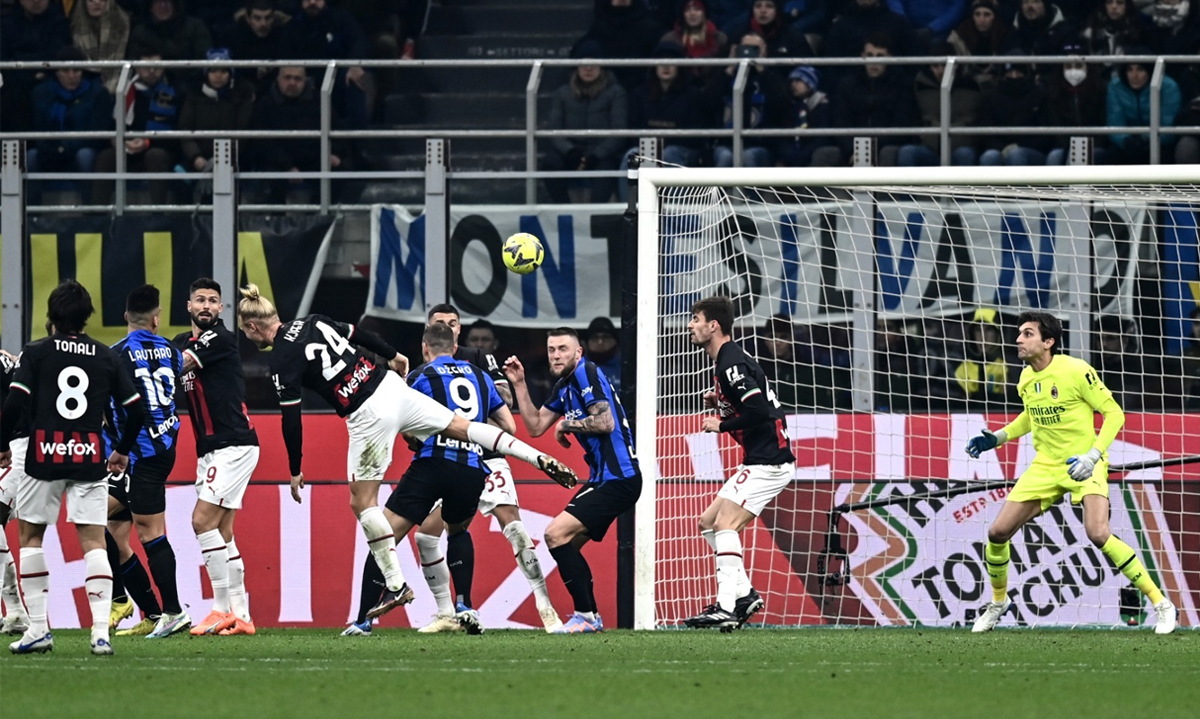In the second edition of the Derby della Madonnina in just three weeks, Milan’s horrible run of from extended as they lost again to bitter cross city rivals Inter. However, it was not for a lack of changes as Stefano Pioli’s men lined up in a novel shape. The question of what Milan learned from their 0-3 thrashing in Saudi Arabia would become evident quickly.
Inter as expected lined up in their standard 3-5-2 formation that has been a constant throughout all their fixtures this year. Milan however began in a 5-3-2 shape that also had the potential to play as a 3-5-2 to try and combat being overran by the potent Inter midfield. The biggest surprise was to see Rafael Leao dropped from the starting eleven.
Leao has been Milan’s bets player throughout the whole season. Pioli explained his decision citing that the two-striker style he employed more suited for Olivier Giroud and Divock Origi. However, a second potential explanation could be that Milan become very one dimensional in close games as the whole offense runs down the left side through Leao. Pioli may have thought by not including the Portuguese international that his team may be less predictable going forward.
It became very clear early in the match that Milan were in for a long night. Inter completely dominated midfield and looked to be the better side by far. Milan looked confused and unsure of how to contain Inter in their new shape. At times Milan were in a 5-4-1 where Origi was dropping into a pseudo number ten role leaving Giroud to be isolated against Inter’s back three. This might have been the area where Leao’s absence hurt Milan the most. Leao is far more dynamic than Giroud. That begs the question, if the game plan was to counter, why Giroud was the first-choice number nine. The inability to counter effectively allowed Inter to play an extremely high line and pin Milan back.
Inter were able to seize control of the game, by dominating possession. They controlled the midfield and were able to effectively exploit width. The width came from Milan sitting in a low block allowing the wing backs to have free reign of the flanks. The combination of the three midfielders at the heart of Inter’s shape play with a fluidity that allows them to press and be covered in the middle. This makes it difficult for opposition to play out through the middle, and because the wing backs are stepping high, playing down the flanks also becomes no small feat. Milan simply could not handle the press, and were lost in the shape they were sent out by Pioli in.

The other area of the game Inter were able to pose serious threats on were set plays. Again, resulting from Milan’s complete lack of counter attacking play, despite that being the gameplan, Inter were able to commit numbers forward. Often leaving only two players back, Inter were aware they would be more than able to handle a solo Giroud break if it were to arrive after the ensuing set piece. Milan have also been poor in the air during this dreadful run of form. Inter were aware of this and chose to play their corners as on top of the goal mouth as possible. Ultimately, Inter scored from a corner, and forced two high quality saves from corners that looked to be heading in directly.

Beside for committing men forward, Inter set a line of players on the top of the box. This was dual purpose. First to cycle the ball back in if it were to leave the box. Second, it stopped any potential Milan counter. By having this line, they were able to put five players directly in front of the keeper and dump the ball right into the dangerous area.
Milan did begin to show signs of life during the second half. The introduction of the more attacking substitutes forced Inter to be more cautious going forward, but it was a story of too little too late. Only having to protect their lead and not score a goal of their own, Inter were more than comfortable to sit back and absorb the pressure at time. Beside for a golden chance that fell to the feat of Giroud, that he squandered with a poor first touch, Milan failed to generate too many good opportunities. The lack of quality can be seen best in the fact that Milan registered their one hundredth completed pass in the 56th minute of the match. Additionally, the Rossoneri failed to register a shot on target, and only managed to shoot the ball four times in the entire match.

Simply put, Pioli tried to counter Inter, and many of his ideas seemed to be logical. Defensively Milan have been struggling so he thought he would put more defensive players across the back. They were overrun by Inter in midfield the last time the two sides played, so he put more played in the midfield areas. However, none of it was enough, and that is the alarming thing for Milan. Pioli tried to outplay his opponent on the tactic board but forgot that the match was played on the pitch. The gap between the two teams geographically is nonexistent, but in the quality of play could not have been farther.

